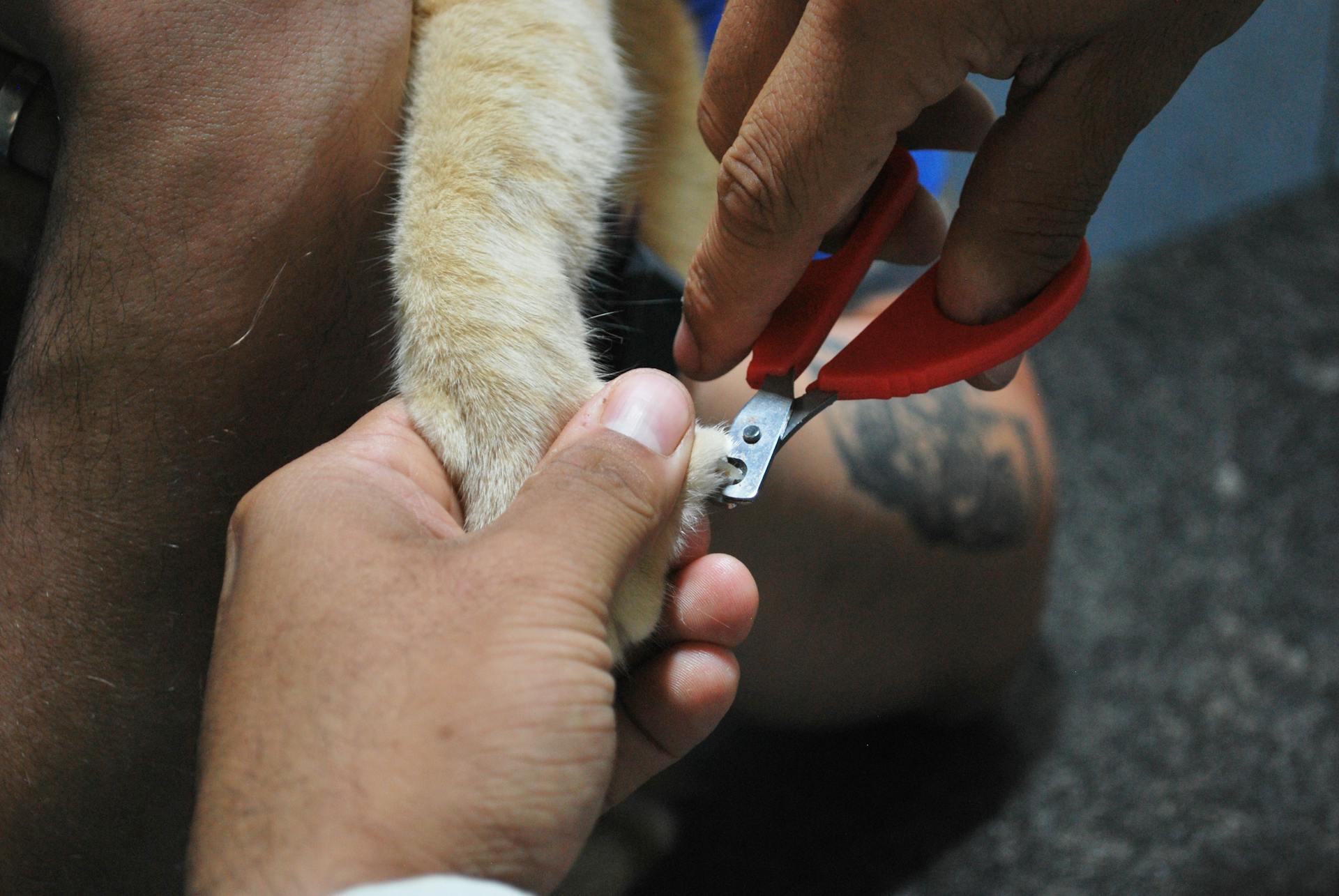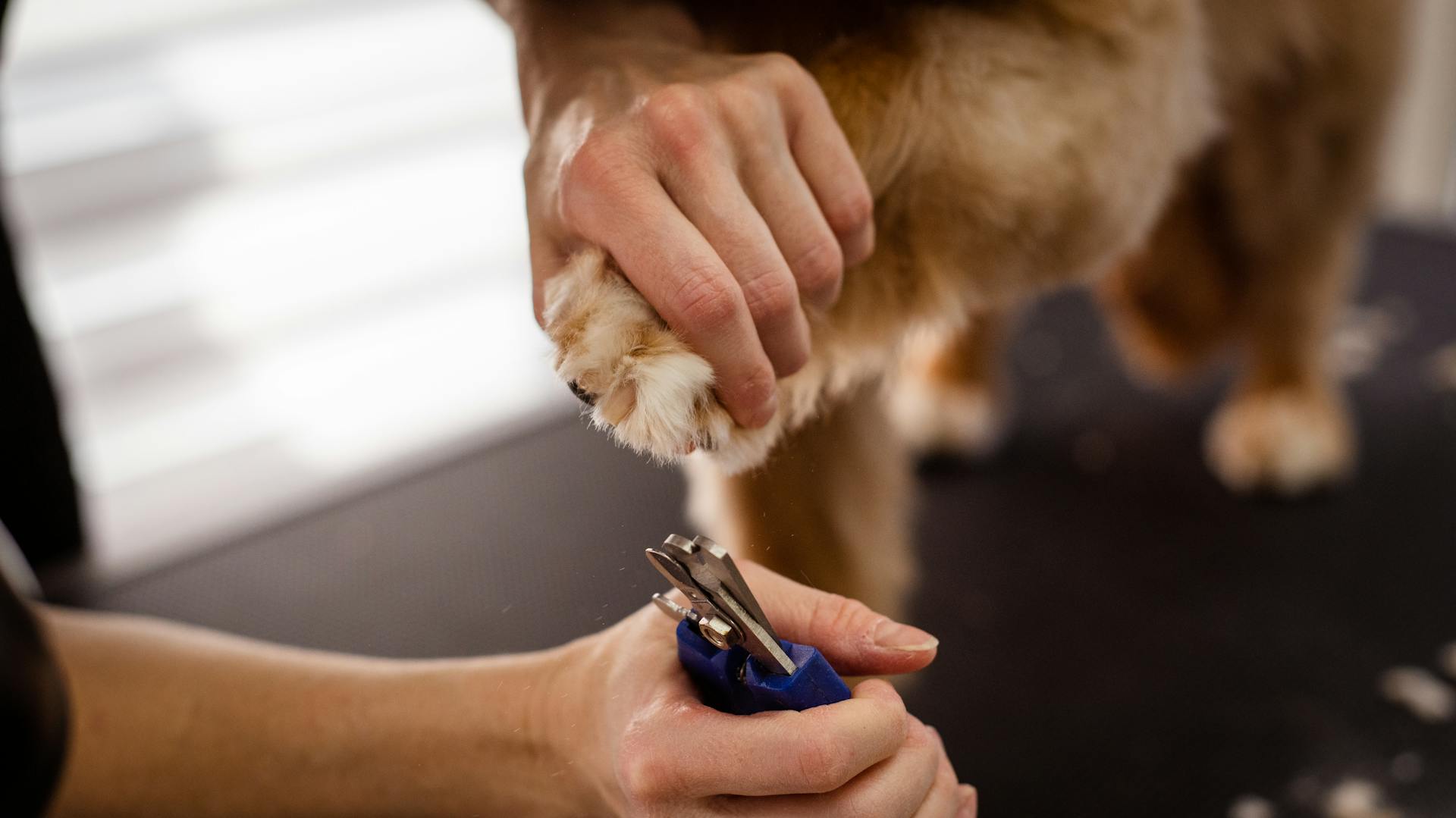
Grooming your dog at home can be a great way to strengthen your bond and save money on vet bills. Regular grooming helps remove dirt and debris that can irritate your dog's skin.
Brushing your dog's coat at least once a week can prevent matting and tangling, which can be painful for them.
Investing in a good quality brush that suits your dog's coat type is essential.
Regular nail trimming is also crucial to prevent overgrowth, which can cause discomfort and health issues. Overgrown nails can even lead to arthritis in older dogs.
Curious to learn more? Check out: Husky Blowing Coat before and after
Brushing
Brushing is an essential part of dog grooming, and it's not just about making your dog look good - it's also about their health and well-being. Regular brushing can help remove dead hair, prevent matting, and distribute natural oils throughout the fur, keeping it glossy and healthy.
Daily brushing is recommended for most dogs, but the frequency may vary depending on the breed and coat type. For example, dogs with short, smooth coats may only need brushing once a week, while dogs with long, silky coats may require daily brushing.
Using the right brush for your dog's coat is crucial. For longhaired dogs, pin brushes with long, round-ended stainless-steel or chrome-plated pins are best, while bristle brushes are suitable for short-, medium-, and some long-coated breeds.
Here's a quick guide to help you choose the right brush for your dog:
Remember to brush your dog in the direction of hair growth, and check for burrs, mats, and any cuts or scrapes on the skin. Regular brushing will also help keep shedding under control and prevent skin infections.
Bathing and Hygiene
Bathing your dog is an essential part of dog grooming, and it's essential to do it right to keep their coat clean and healthy.
Regular baths can help reduce shedding and promote skin health. However, over-bathing can strip your dog's coat of its natural oils, leading to dryness and harshness.
Your dog's coat type will determine how often they need to be bathed. Short-haired dogs can get away with a bath every 4-6 weeks, while long-haired dogs may need to be bathed every 4-8 weeks.
You might enjoy: Pomeranian Dog Bathing
If your dog has a short, smooth or wiry coat, brush them once a week with a rubber-bristled brush. For long-haired dogs, brush them once a day to prevent tangles and mats.
Before bath time, brush your dog thoroughly to prevent mats and tangles. Use a mild shampoo specifically formulated for dogs, and avoid getting it in their eyes or ears.
Use a damp cloth or cotton ball to wipe away outer eye discharge and gently clean away outer ear wax. Never push anything into your dog's eyes or ears.
After the bath, dry your dog thoroughly with a microfiber towel and/or a hair dryer on a low setting. Move the dryer in a back-and-forth motion, holding it away from your dog's skin to prevent burns.
Here's a rough guide to help you determine how often to bathe your dog:
Remember, it's better to err on the side of caution and under-bathe your dog rather than over-bathe them.
Take a look at this: Do You Bathe a Dog before Grooming
Nail Care
Your dog's nails must be short for their feet to remain healthy. Long nails can make walking awkward or painful and even lead to a trip to the veterinarian.
You can make nail trimming a painless procedure by getting your dog used to having their feet handled in puppyhood. Start trimming gently, a nail or two at a time, and your dog will learn that you're not going to hurt them.
It's essential to use a specially designed nail clipper with safety guards to prevent cutting the nails too short. You want to trim only the ends before the "quick", which is a blood vessel inside the nail.
Suggestion: How to Trim a Dachshunds Nails
De-Shed Your Coat
De-Shed Your Coat is a crucial part of dog grooming. Regular de-shedding can reduce shedding by up to 90% with the right tool.
Using a de-shedding tool like the Furminator can be a game-changer for dog owners. These tools are designed to safely remove dead fur that's loosely attached, making them perfect for shedding dogs.
A different take: Curly Coated Retriever Shedding
Before bathing, use a force blower to remove excess fur. This will make the bathing process much easier and more effective.
Deshedding your dog is not just about making them more comfortable as the seasons change, it's also about reducing the amount of dog hair that's free floating around your home.
Broaden your view: Dog Grooming Bathing Systems
Toenail Trimming
Trimming your dog's toenails is an essential part of their nail care.
You should be able to hear the nails clicking on the floor if they're too long, which can cause discomfort and even pain for your dog.
Long nails can also break easily, especially at the base of the nail, which can lead to a trip to the veterinarian.
To trim your dog's nails safely, use a specially designed nail clipper with a safety guard to prevent cutting the quick, a blood vessel inside the nail.
You can start trimming your dog's nails as early as puppyhood to get them accustomed to having their feet handled.
Take a look at this: How Long Does Dog Grooming Take

If you accidentally cut the quick, stop the bleeding with some styptic powder.
It's essential to trim your dog's nails regularly to prevent pain and infections, and to maintain their overall health.
You should trim your dog's nails every 4-6 weeks, or as often as needed, depending on their nail growth rate and lifestyle.
For example, dogs that walk on concrete may need fewer trims than those that run on grass.
Remember, trimming your dog's nails is a process that takes time and patience, but it's worth it for their comfort and well-being.
Start with small steps, like trimming just one or two nails at a time, and reward your dog with treats and praise for their cooperation.
See what others are reading: How to Cut a German Shepherds Nails
Ear and Eye Care
Cleaning your dog's ears and eyes is an essential part of their grooming routine. You should clean your dog's ears once a month or more often if they're prone to ear problems.
Take a good look inside and smell each ear and ear canal for signs of infection, such as severe redness, swelling, debris, discharge, or a fetid odor. Any of these signs may require a visit to your veterinarian.
It's also important to thoroughly dry your dog's ears after they get wet, as this can help prevent infection.
Consider reading: Dog Ear Grooming Styles
Ear Cleaning
Ear Cleaning is a crucial part of your dog's overall health, and it's easier than you think.
You should clean your dog's ears once a month, or more often if they're prone to ear problems. This regular cleaning helps prevent infections and keeps your dog's ears healthy.
Never force anything into your dog's ear, as this can cause more harm than good. Always use a gentle approach when cleaning their ears.
Some dogs need the hair plucked just inside the ear to keep air circulating, so it's a good idea to ask your veterinarian if this is necessary for your dog.
Take a good look inside each ear and ear canal after cleaning, and smell for any signs of infection.
Curious to learn more? Check out: Dog Ear Infection after Grooming
Eye Cleaning
Eye cleaning is a crucial part of your dog's grooming routine. Make sure to check for redness or other signs of irritation before cleaning their eyes.
Gently wipe away any discharge in the corners with a cotton ball or soft washcloth moistened with warm water. Be gentle and avoid rubbing the cotton ball directly over the eye.
Only use products designed for dogs, such as wipes or an eye wash, to clean their eyes. These products are specifically formulated to be safe and effective for your furry friend.
Check this out: Dog Eye Irritation after Grooming
Tools and Equipment
To get started with dog grooming at home, you'll need the right tools and equipment. A rubber-bristled brush, wire slicker, steel comb, and/or de-shedding tool are essential for removing loose hair and preventing matting.
You'll also need nail clippers specifically designed for dogs, as well as a Dremel grinder for trimming and shaping their nails. Don't forget a styptic pencil to stop any accidental bleeding.
Toothbrush and toothpaste specifically designed for dogs are necessary for maintaining their oral health. Cotton balls and soft, reusable cloth squares come in handy for cleaning their ears and eyes.
Blunt-ended shears and/or a small clipper with guide combs are necessary for trimming their fur. Shampoo and conditioner specifically designed for dogs are also essential for keeping their coat clean and healthy.
A microfiber towel is perfect for drying them off after a bath, and a hair dryer can be used to speed up the drying process.
Here's a list of the basic tools you'll need to get started:
- Rubber-bristled brush
- Wire slicker
- Steel comb
- De-shedding tool
- Nail clippers
- Dremel grinder
- Styptic pencil
- Toothbrush and toothpaste
- Cotton balls
- Soft, reusable cloth squares
- Blunt-ended shears
- Small clipper with guide combs
- Shampoo and conditioner
- Microfiber towel
- Hair dryer
Sources
Featured Images: pexels.com


